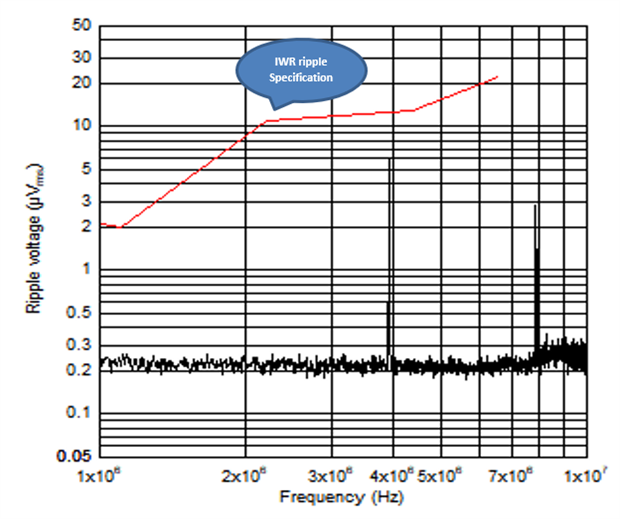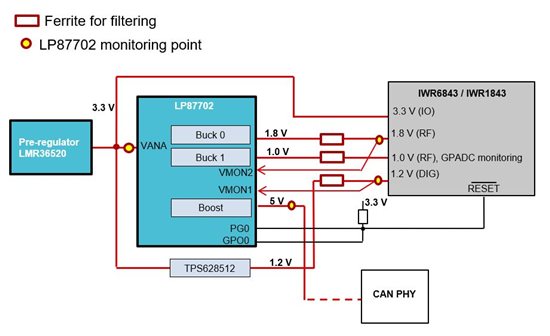SSZT172 april 2021 IWR1843 , IWR6843 , LP87702 , LP87702-Q1
For years, passive infrared sensors and lasers have sensed remote objects or measured range in applications such as robotics, level sensing, people counting, automated doors and gates, and traffic monitoring. But with demand for higher precision and resiliency against environmental influences such as bad light, harsh weather conditions and extreme temperatures, it is inevitable that millimeter-wave (mmWave) radar technology will take over.
mmWave technology provides ultrawide resolution, better calibration and monitoring, and highly linear signal generation for accuracy in radio-frequency (RF) sensing. These benefits enable the detection of objects in otherwise obstructed views for intelligent safety in forklifts and drones, and enhance sensing performance that improves power in intelligent streetlights and perimeter security.
For autonomous guided vehicles (AGVs) and collaborative robots (cobots) in industrial automation, mmWave technology offers not just high accuracy but preserves safety by helping avoid collisions of AGVs with other objects or human accidents caused by cobots.
The low noise and thermal performance of a radar’s power solution also plays a major role in its ability to sense, image and communicate the range, velocity and angle of remote objects with high accuracy.
In this article, I’ll discuss power-supply design challenges that are applicable to any radar processor in the industry, using the 60- to 64-GHz IWR6843 and 76- to 81-GHz IWR1843 mmWave radar sensors as examples.
Let’s begin with the most important power specifications and how you can best meet those parameters.
Tight Ripple Specifications
Ripple is an unwanted side effect of switching regulators that is normally suppressed by the design architecture or output filter selection. Ripple directly affects the output voltage accuracy and noise level, and thus the RF performance of the system.
The RF rails of a radar processor are sensitive to supply ripple and noise because these supplies feed blocks in the device such as the phase-locked loop, baseband analog-to-digital converter and synthesizer. The IWR6843 and IWR1843 processors have RF rails (1 V and 1.8 V) with very tight ripple specifications in the microvolt range. It’s common practice to use low-dropout regulators on RF rails because of low noise, but high-current LDOs (>1 A) are costly and depreciate the system’s thermal performance.
In order to meet low ripple specifications, I recommend using regulators with a high switching frequency, which will enable you to select smaller passive components (inductors, output capacitors) in the design architecture and achieve the necessary ripple amplitude.
Figure 1 shows the output ripple performance of TI’s LP87702 device, which integrates two step-down DC/DC converters switching at a high frequency (4 MHz) and meets the ripple specs of the IWR6843 RF rail without the use of LDOs. The LP87702 supports spread-spectrum switching frequency modulation mode, which further helps reduce both the switching frequency spur amplitude and electromagnetic interference spurs.
 Figure 1 The LP87702’S 1-v Ripple
Performance against IWR6843 Ripple Specifications, with a Low-cost Second-stage
Inductor-capacitor (LC) Filter Using MPZ2012S101A Ferrite
Figure 1 The LP87702’S 1-v Ripple
Performance against IWR6843 Ripple Specifications, with a Low-cost Second-stage
Inductor-capacitor (LC) Filter Using MPZ2012S101A FerriteOptimized Thermal Performance
The miniaturizing of devices has increased the heat generated per unit area in printed circuit boards; mmWave radar designs are no exception. For compact radar applications such as automatic lawn mowers or drones that also have plastic housing, thermal management becomes a priority; increased board temperatures not only reduce mmWave sensor lifetimes but also affect RF performance.
The major contributors for thermal dissipation in a radar power architecture are high-current LDOs, which add significant (>1 W) heat to the system and also affect RF performance. Plus, high-current LDOs are not only expensive; they require a heat sink, adding more cost to the system. Designing the power architecture of a radar system without LDOs prevents them from deteriorating a system’s thermal performance and increasing the overall cost and solution size from external components.
Figure 2 shows how the LP87702 integrated power-management integrated circuit (PMIC) and external DC/DC step-down regulator can power all of the RF rails of the IWR6843 or IWR1483 processor. The 5-V rail from the integrated boost supports the Controller Area Network-Flexible Data Rate interface, typically required in AGVs and industrial robots.
 Figure 2 IWR6843 or IWR1843 Power Block
Diagram
Figure 2 IWR6843 or IWR1843 Power Block
DiagramA two-IC solution distributes hot spots and removes the need for an external heat sink, reducing overall system cost. The integrated 4-MHz buck converters (Buck 0 and Buck 1) eliminate the need for high-current LDOs, thus improving overall efficiency and thermal performance while meeting the IWR6843 noise performance with a low-cost LC filter.
The LP87702 device also includes a protection feature against overtemperature by setting an interrupt for the host processor.
Industrial Functional Safety
Industrial functional safety standards are more important than ever, as humans are increasingly interacting with autonomous robots, safety scanners in factory automation settings, automated pedestrian doors, and industrial doors and gates. These systems must be able to detect anomalies and react accordingly.
TI’s LP87702-Q1 dual buck converter supports functional safety requirements up to Safety Integrity Level (SIL)-2 at the chip level, which are specified for end equipment such as AGVs and industrial robots. By integrating two voltage-monitoring inputs for external power supplies and a window watchdog, the LP87702-Q1 helps reduce system complexity and eliminates the need for an additional safety microcontroller. By providing chip-level compliance, the LP87702-Q1 also helps streamline time to market.
SIL risk levels are determined by International Electrotechnical Commission (IEC) 61508, an international standard to help ensure safe operations between human and robotic interaction, including cobots.
Conclusion
Although LDOs offer a low-noise option for powering the RF rails of a radar processor, they can complicate overtemperature considerations, SIL compliance and system designs, and require additional components. Consider PMICs, which offer better thermal performance and ease of design.
Additional Resources
- See the LP87702 data sheet.
- Read the “Power Supply Design for xWR Radar Using LP87702K-Q1” user’s guide.
- Check out the application report, “Power Management Optimizations – Low Cost LC Filter Solution.”